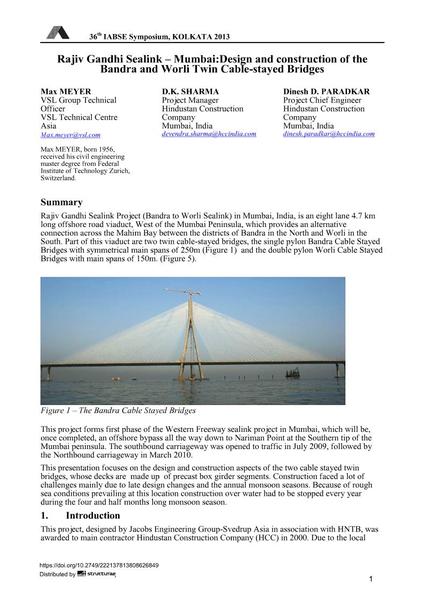Rajiv Gandhi Sealink – Mumbai: Design and construction of the Bandra and Worli Twin Cable-stayed Bridges

|
|
|||||||||||
Bibliographic Details
| Author(s): |
Max Meyer
D. K. Sharma Dinesh D. Paradkar |
||||
|---|---|---|---|---|---|
| Medium: | conference paper | ||||
| Language(s): | English | ||||
| Conference: | IABSE Symposium: Long Span Bridges and Roofs - Development, Design and Implementation, Kolkata, India, 24-27 September 2013 | ||||
| Published in: | IABSE Symposium Kolkata 2013 | ||||
|
|||||
| Page(s): | 1-7 | ||||
| Total no. of pages: | 7 | ||||
| Year: | 2013 | ||||
| DOI: | 10.2749/222137813808626849 | ||||
| Abstract: |
Rajiv Gandhi Sealink Project (Bandra to Worli Sealink) in Mumbai, India, is an eight lane 4.7 km long offshore road viaduct, West of the Mumbai Peninsula, which provides an alternative connection across the Mahim Bay between the districts of Bandra in the North and Worli in the South. Part of this viaduct are two twin cable-stayed bridges, the single pylon Bandra Cable Stayed Bridges with symmetrical main spans of 250m and the double pylon Worli Cable Stayed Bridges with main spans of 150m. This project forms first phase of the Western Freeway sealink project in Mumbai, which will be, once completed, an offshore bypass all the way down to Nariman Point at the Southern tip of the Mumbai peninsula. The southbound carriageway was opened to traffic in July 2009, followed by the Northbound carriageway in March 2010. This presentation focuses on the design and construction aspects of the two cable stayed twin bridges, whose decks are made up of precast box girder segments. Construction faced a lot of challenges mainly due to late design changes and the annual monsoon seasons. Because of rough sea conditions prevailing at this location construction over water had to be stopped every year during the four and half months long monsoon season. |
||||

